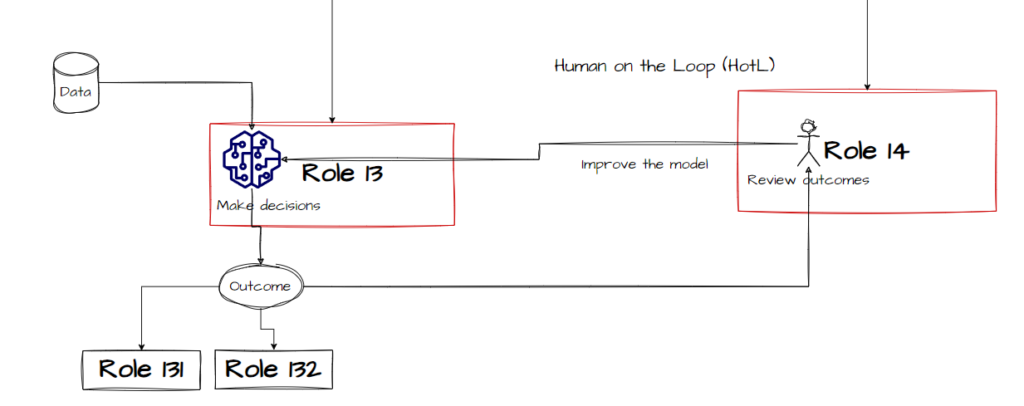Right now everybody is convinced the new generations of AI solutions are going to have an impact on many aspects of life.
In corporate world this is going to be impacted too. How? I really do not know how, but I would like to expose some ideas about the topic focusing on organizational charts of corporations.
We all have seen organizational charts, these boxes with a waterfall approach that goes from role 1, then role 11, role 12, etc. Big organizations have layers that go from 8 to 12, or even more.
In all of these boxes there is a name, the name of a human.

My bet is that some of these names are going to become an autonomous system.
As there are different types of autonomous systems, there will be different type of substitutions, being them gradual.
Human in the Loop (HitL)
Human in the loop is already happening, since years, there is not anything new here. A human making decisions with the support of data or information provided by a machine.
When this happens the substitutions is hard as it’s the human in control of the decisions and it’s accountable of the outcomes.

Human in the Loop for Exceptions (HitLfE)
Human in the Loop for Exceptions, suddenly a role can be isolated in a way that the work can mainly be performed by a system. The exceptions are launched, but not to a similar person but to the upper layer in the organizational chart. This role (in the example=Role 12) is the one that stays accountable of the decisions.
You could think, if the role is performed by a system, why do the company keep it in the organizational chart? There could be different reasons, for instance:
- It could be that the role is representing a function, but this function needs to be represented as it performs a compliance function the company need representation. In this case higher role in the hierarchy (role 12) stays accountable.
- It could be that the person performing the role (role 121) is there and part of its decisions are already automated, but not all of them. Here the question for role 121 is: how valuable is that role for you?
- It could be that the person performing the role (role 121) is automating its own work to focus on his career taking more responsibility or trying to move to other space of the organization.
- It could be that the person performing the role (role 121) is just clever and lazy and finds the way to have a better day to day.

In this transition from human to system, in middle manager roles, the role of the email plays an important system, as it is the receiver of many requests that could be performed by a system.
- What if you can define rules and specific agents that replies emails to certain requests?
- What if you can define rules and specific agents that draft emails to certain requests making the human to have already something ready?
- What if you can define rules where you require more information from the sender?
- Etc.
Human on the Loop (HotL)
Human on the Loop is where the 100% of the decisions are made by the system and the human plays the role of improving the model.
In this case I have represented it in a way where the human is at the same level than the automated role (role 13 is automated and role 14 performs the role of supervision and improvement).
I have done in this way, because originally this could be just one role where the organization, and suddenly they see some benefits or need to split the role in two. This could be another way in which automated roles could emerge.

Human out the Loop (HootL)
Human out the Loop is a type of automation system that I do not see how it could be part of the equation proposed here. It contains many variables and second level consequences that I’m not able to foresight. But it’s there and it could be that some roles are implemented in this way.
For instance, a role where some type of compliance check is done and the system learns by itself changes in the legislation.

Where are the weak signals?
Well, it’s not weak at all right now, it’s more strong signal to me than weak, but it requires time to evolve. AI Agents are already present in the process automation space, and there’s now a hype. It’s a question of time than a solution comes in the space of corporations.
I personally look forward to Microsoft (outlook) and Google (gmail) to take the lead here.
Takeaways
I believe this is going to be something happening in some way, and that the email, that has been years behaving as a commoditized service is going to be key in this change.
What are your thoughts?